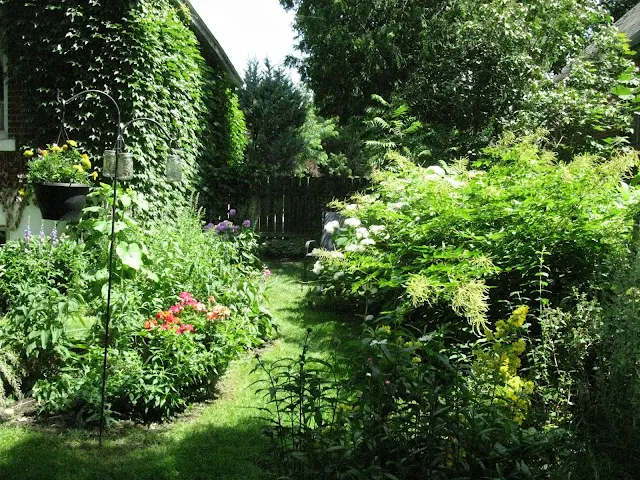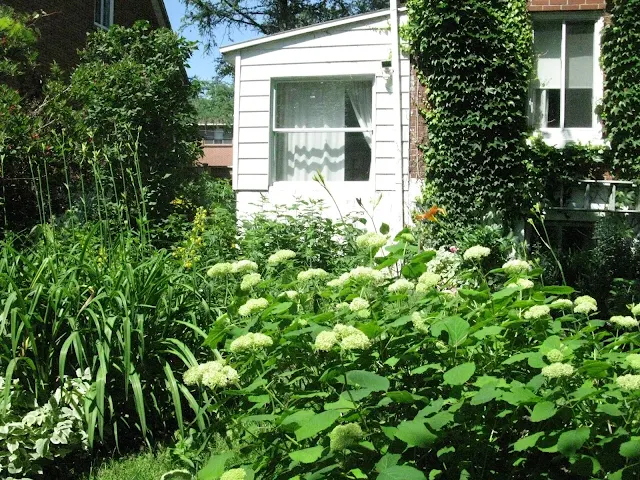These New England asters are growing near the senior campus of Willingdon School on Coronation Avenue near here; you see them everywhere, they're like weeds.
Friday, September 16, 2022
Wednesday, August 24, 2022
Honey bees on the corner of Mayfair and Terrebonne
For several years I've seen honey bees in the hydrangea bush on the corner of Mayfair and Terrebonne. I like seeing honey bees having been a beekeeper years ago, and most summers they're in my garden. By the way, this garden on Terrebonne is especially nice, it's probably one of the nicest gardens around here; it's not a typical garden, more of a cottage garden.
Thursday, August 18, 2022
The garden's progress: mid-August
When August begins the days grow shorter; now it's getting dark by 8 p.m. There is also the smell of August in the air, it's something I've noticed since I was a child; that smell of August coincided with shorter days and told me that summer didn't have long to last and then it was back to dreaded school in a few weeks and the end of my freedom. Now, the insects are singing at night, I hear them before bed around 11:30 p.m. and again at 5 a.m. I used to think fireflies were finished their business by mid-July but this year I saw them at the beginning of August; they say it was a hotter than usual summer but it seemed an average summer for heat except for the fireflies. Now we are on the downward slide to fall.
Tuesday, July 19, 2022
The garden's progress; the height of summer
Monday, July 11, 2022
The garden's progress; insects, birds, and urban wildlife
A large lawn is like a paved parking lot; it is better than a parking lot but not a lot better. I can see this everyday in my garden; a garden attracts a variety of insects, more insects every summer, and more birds every summer, a lawn doesn't attract anything. If this is important to you, or interests you, then plant more flowers or vegetables, plant a perennial garden; this way you'll be making a home for insects, birds, and urban wildlife that will never know you have made their habitat a better one for them, they will make use of your garden as they would anywhere else in the natural world. Also, you'll be making your environment a lot nicer for yourself and you'll also be doing a service to the insects, birds, and urban wildlife. One of the good things about nature is that it doesn't take long for it to return; the only ghosts in ghost towns are human ones, nature is quick to move in and make deserted towns their own. In the old days we all sang Joni Mitchell's song, "they paved paradise and put up a parking lot", now we know that the parking lot didn't necessarily last long and paradise returned.
Photographs of my garden taken on July 7, 2022.
The next morning I took these photos:
Monday, June 27, 2022
Now, for the garden's progress
These photographs were taken a few days ago, on June 24. Last week it poured rain but now it is bright and sunny, because of this the garden is thriving, it has taken on a life of its own. It is no longer "my" garden that I planned and planted, dug and hoed, but a garden that has an existence of its own. Now, it's just garden maintenance for me. Now, the garden is visited by more birds and insects than before; phlox is blooming purple and day lilies and cone flowers, hostas, lavender, and roses are beginning to flower. Even the little birds take the garden for granted as they come and sit in the bird bath. Every garden will benefit by having water in it, even just a bird bath; Sir William Temple writes,
In Every Garden four things are necessary to be provided for, Flowers, Fruit, Shade, and Water; and whoever lays out a Garden without all of these, must not pretend it in any Perfection. It ought to lie to the best Parts of the House, or to those of the Master's commonest use, so as to be but like one of the Rooms out of which you step into another.
--Sir William Temple, 1628-1699,
Upon the Gardens of Epicurus,
in The Oxford Book of English Prose (1925)
Monday, August 23, 2021
Getting Started on a Canadian Cottage Garden
How did I begin my Canadian cottage garden? How did I get started? I began by removing a lot of small trees--these were barely saplings--that had begun to grow on the edge of the yard. None were more than four feet tall, they were like weeds and had self-seeded; I didn't want them to grow any taller, I like trees and when I lived in the country I never cut down any trees, but these city trees would make a small backyard darker than it already was. Then, I noticed the hydrangeas in the front of the house had gotten out of control, it was a lot of work but I dug some of them up and a few of the hydrangeas I didn't discard were moved to the backyard. I don't like waste but I do like tidy and, despite liking cottage gardens, I also like a certain homey austerity that favours frugality. While doing this I moved some raspberry canes from one side of the garden where they had been planted many years before, and neglected, when the yard had more sunlight, and I transplanted them to a sunny area near the attached room by the side of the house. I pulled up weeds and then I began planting perennials; this was in 2016 and 2017. This was the beginning of the transformation of a barren backyard, grass with weeds and trees growing on the perimeter, into a cottage garden.
I used to watch those home improvement shows on HGTV, someone would buy a run-down 1950s bungalow and then the home improvers would arrive, they've become celebrities, and quickly decide to rip out the purple bathroom and old fashioned kitchen, and make the whole place open floor concept, just a huge room. Nowadays, apparently, people want walls since they`re working and staying at home a lot of the time, they want some private space. The renovated old bungalows look better because they`re fixed up, painted, but they all look the same. They look like the places that are staged by real estate agents, nothing is personal, no family photos or anything familiar is allowed, books are in storage, its a soulless environment meant for a potential buyer. After a few years of watching these programmes on television I began seeing some truly ugly renovations. That was when I decided that just about anybody could do this job, but not the physical work involved; go to a big box hardware and buy whatever is the latest in faucets, tiles, paint colours or wall paper, fake fireplaces, appliances and back splash tiles, cabinet and drawer pulls, and you will end up with a contemporary house. But not a home, that requires people. I must add that taking a home built in 1950 and tearing down the walls, or a home from 1870 and making it contemporary, destroys the original ambience of the home; you may as well tear the house down and begin again, you have destroyed the original architecture of the building`s interior and, especially in an older house, you have not restored it, you have destroyed it. I know this because after I sold our 1870 country home someone bought it and destroyed it with their renovations.
There are two approaches to poetry and gardening, two types of poets and gardeners: classical and romantic, formal and informal. I have known people who buy annuals every spring and lay out perfect gardens, designed with colour and plant in mind, height and appearance, and placed in garden beds along the edge of the garden. These gardens are a lot or work and they look pretty good. These are the classicist middle class gardeners. On the other end of the spectrum are the romantics, these are the cottage gardeners. Of course, most gardeners are somewhere in the middle, neither formal nor informal, they have lovely city or country gardens. I won`t bother with the non-gardeners, the patch of dying grass with no flowers, or one or two flowers, a few impatiens, and so on.
I was reading someone`s comments on how to plant a cottage garden. Tall spiky flowers go together, similar colours go together, and so on. Some planning is important, in fact I do a lot of planning, usually it`s about where I will expand the garden and if I have the time for maintaining a larger garden. I am fairly slow at this type of thing and it may take a few years to fully implement my plans, it may even take up years I have fewer of. But, otherwise, there is not a lot of planning for country gardens; I favour gardens that are anarchic and show some returning to nature. This is especially true of the cottage garden.
Over the years I have enjoyed walking by the city farm garden behind the student residence at the Loyola Campus of Concordia University. They grow food for food banks and they used to also sell what they grew at a market. Now, the garden and herb area has been more or less abandoned and it has gone, as they say, wild. But the flowers and other plants are still there, cone flowers, daisies, horse radish, different herbs, fruit berries, lilac bushes, and so on. It all needs a good watering and it is now anarchic and unorganized; it has moved towards the wild category. But in nature what seems unorganized only means it is untouched by people. Order is imposed by the observer, it may not be inherent in the garden. This area of the former city farm garden is now a cottage garden and it is doing its best to survive since no one ever waters or weeds it, but it is still a garden and it is enjoyable as it is. In effect, we might define a cottage garden as controlled wilderness, a contradiction but the best I can do.
My only rule for my garden, other than the obvious--water your plants, maximize sunlight, buy plants in your hardy zone or they may not last the winter--is that the tall plants are in the back of the flower beds, the shorter plants are in the front of the flower beds, but this is common sense.









.jpg)







































